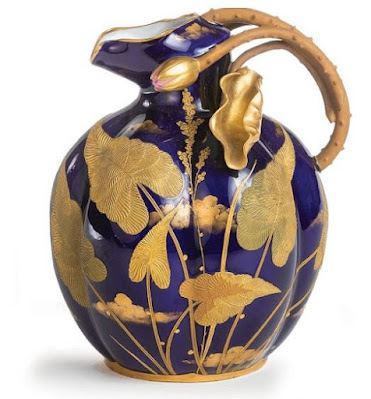I won't get to New York this month, but I still get my magazines with art.
Gustav Klimt. "Lady with a Fan." 1918. Austria.
This was Klimt's last painting and found on an easel in his studio
in Vienna, when he died at age 55. It sold recently at auction
in London for $110 million.
Ceramics began in America as a functional craft. But by the late 19the century,
many ceramic artists aimed for something higher. Walter Scott Lenox in New Jersey
created this beautiful porcelain "Decanter Set" in 1905, based on Irish Belleek
porcelain. It is in a show at Charlotte's Mint Museum.
Another example of Belleek style porcelain is this pitcher from 1895.
A Belleek porcelain style coffee pot with
enamel overlay and special ivory coloring.
Inka Essenhigh is new to me. She combines fantasy and flowers.
"The Last Party." 2020, enamel on canvas, 24x24
Inka Essenhigh. "Yellow Breath" 2022. 50x40
Inka Essenhigh. "The Flower King." 2022
enamel on canvas, 76x62
Currently there is an exhibit in Vienna of the work of the German Expressionist,
Gabriele Munter. She is usually relegated to a side note beside her more famous
partner, Vassily Kandinsky. The exhibit shows she clearly deserves to be regarded
with the same respect. Her use of simplified forms, strong outlines, and intense colors
in "The Blue Lake" of 1934 are typical.
Gabriele Munter. "Kandinsky at Tea Table." 1910
Her portrait of the famous artist at their breakfast table.
He was clearly as influenced by her style as she
was by his.
Gabriele Munter. "Evening Landscape with White Moon." 1940.
Kandinsky simply walked out and left.
In Paris and now New York, there is a show of works of
Edouard Manet and Edgar Degas, friends and rivals. The two of them
laid the foundations for modern art and were looked upon as radicals in
their time. The is "The Absinthe Drinker" by Degas from 1875.
While everyone else was painting perfect goddesses in the center of
canvases, Degas sits in a real Parisian cafe, right behind the
marble table top we see. The walls are tilted to suggest an enclosed\room,
the floor is tilted to bring us right in, and the real shop girl is exhausted
from standing up all day and drinks the highly alcoholic drink.
Edouard Manet also cuts a slice of real life, two of his friends out on a boat in the
Bois de Boulogne. The sail and the lady are cut off, as if we are looking so close
we cut out the background. And his tee shirt and pants are painted flatly, with
only slight shading, so they seem to jump out and be right in our space.
Edgar Degas. "The Cotton Office in New Orleans." 1873
He again uses the angled walls to suggest an enclosed room, the tilted floor to bring us
into the picture, and that is his uncle sitting in front. He cuts off the right
and lower portions so we feel we are peeking in on a real scene.
But Edouard Manet's "Olympia" of 1863 really aroused the critics and politicians. It was
condemned as immoral, filthy, unfit to be looked at, etc. The painting was surrounded
at the exhibit by hundreds of paintings of nude goddess and mythological figures.
But "Olympia" was real. We know what she was. (The model was actually a famous
actress and painter.) Manet flattens out the areas of color instead of making
infinite gradations of shadow. She is right there at the front of the canvas, no apologies.
An art exhibit in Albuquerque this month has works by the English sculptor,
Henry Moore, and the American painter, Georgia O'Keeffe, both of whom were
very much influenced by nature, as their subject matter. This is Moore's
"Reclining Figure" of 1951.
Georgia O'Keeffe's "Red Cannas" of 1927 simplified and
abstracts nature in a different way.
Georgia O'Keeffe's "Ram's Head, Blue Morning Glory" of 1938
shows her use of bone-like forms, akin to Moore's.
Robert Duncanson was one of the great Black artists of the 19th
century. Before the Civil War he made an extended trip through
the Southeast, painting landscapes in the style of the Hudson Valley
School. "Sketching Lookout Mountain" in 1851 captures the
atmosphere of the area, as well as has two black figures in the
foreground. This was very unusual. These are among
40 paintings in a show in Fredericksburg, VA.
Robert Duncanson. "Bend in the Shenandoah Valley" in 1856 captures the light
so beloved of the Hudson Valley School, as well as a self-portrait of himself
and his wife in the foreground.
Dennis Lee Mitchell. "Flower." 48x48
Mr. Lee creates his works with smoke. He uses a blow torch near the
large sheet of paper and achieves unusual shading effects.
Emeralds and Diamond Earrings
Amethyst and Diamond Ring
__




























.JPG)































